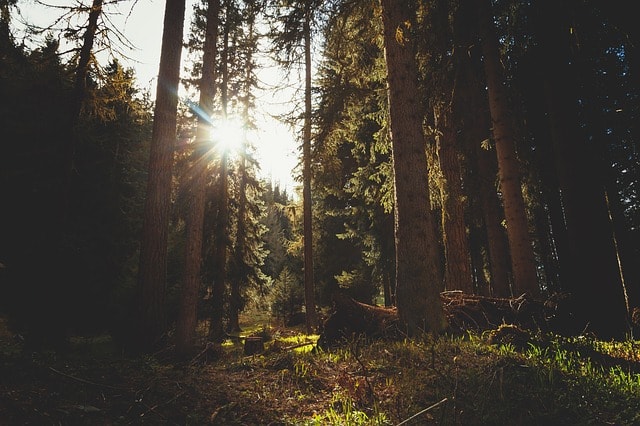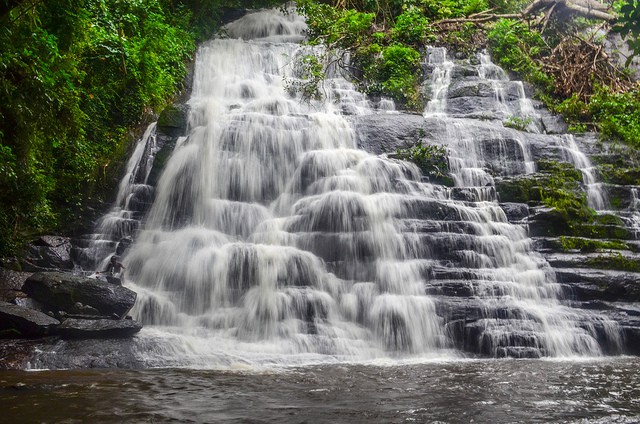What is Water Evaporation? Process and Excellent Examples of Evaporation

Generally, evaporation is the process by which liquid matter under conditions of high temperature, escape as gas molecules. Water evaporation, similarly, is a process by which water molecules under high conditions of temperature change phase from liquid to gaseous form (where it escapes as gaseous water molecules or droplets).
Water evaporation occurs because, at high temperature, water molecules vibrate rapidly, which results in some of the molecules gaining enough energy to escape from the lattice network of water molecules. It follows that randomness of molecules increase from the solid state to the liquid state, with the gaseous form being the most random of all states.
Thus, during water evaporation, water molecules move freely as exhibited by smoke like the movement of visibly evaporating water.
Evaporation rate increases with sunlight intensity, temperature, wind speed, ground moisture, and plant cover. The rate decreases as the air humidity increases. The evaporation rate on the earth varies from almost zero on the polar ice caps to as much as 4 m (approximately 13 ft) per year over the Gulf Stream.
The average rate is about 1 m (approximately 3.3 ft) per year. Given this rate, it can be projected that evaporation would lower sea level about 1 m per year if the water were not replenished by precipitation and runoff.
Water evaporation occurs in the earth’s water cycle when energy from the sun causes water to heat up and evaporate from the earth’s surface. There is usually a rise of water into the atmosphere, which condenses to give clouds, and falls back to the earth as precipitation.
Close to 505,000 cubic km (about 121,000 cubic mi) of water evaporates from the earth’s surface each year—about 86 percent of which evaporates from the oceans. The vapor from water then drifts over land masses where the vapor cools, slowing the kinetic energy of the water molecules until attractive intermolecular forces cause the molecules to condense into rain, sleet, snow, or hail. This precipitation replenishes streams, rivers, lakes, groundwater reservoirs, and other freshwater supplies.
A lot of living organisms depend on evaporation to regulate their internal body temperature. For e.g.: performing an exercise causes a person’s muscles to contract, producing heat. Suppose the heat is not transferred from the body to the surrounding environment, the individual’s internal temperature could rise to life-threatening levels.
During vigorous activity, humans give off perspiration as droplets of water through pores in the skin. The water secretions absorb body heat and use this energy to evaporate into the environment, carrying the heat energy with them.
The process of evaporation is used by plants to transport water up from the soil into the leaves. Leaves excrete water through surface openings known as stomata. Molecules of water, therefore, evaporate, pulling (by attractive intermolecular forces) other water molecules up through the plant vessels behind them.
Loss of water from leaf surfaces by is referred to as transpiration. By transpiration, an average-sized maple tree can lose more than 200 L (200 kg) of water per hour on a summer day.
Process of Evaporation
Location near the surface and possession of a sufficient amount of kinetic energy is essential for water evaporation to occur. Such water molecules have must move in the proper direction, and possess sufficient kinetic energy to overcome liquid-phase intermolecular forces.
If only a small proportion of the molecules meet these criteria, the rate of evaporation is low. Because the kinetic energy of a molecule is proportional to its temperature, evaporation proceeds more quickly at higher temperatures.
The fast-moving molecules escape, while the remaining molecules which possess lower average kinetic energy remain and the temperature of the liquid decreases with an increased rate of evaporation. This phenomenon is also called evaporative cooling.
This explains the mechanism by which evaporating sweat cools the human body, Processes of evaporation tends to proceed much faster with higher flow rates between the gaseous and liquid phase and in liquids with higher vapor pressure.
For example, laundry on a clothesline will dry (by evaporation) more rapidly on a windy day than on a still day. The major components of evaporation are air movement, heat and atmospheric pressure (determines the percent humidity).
There are some liquids that do not evaporate visibly at a given temperature in a given gas (e.g., cooking oil at room temperature) have molecules that do not tend to transfer energy to from one to another in a pattern sufficient to frequently give a molecule the heat energy necessary to turn into vapor. However, these liquids are evaporating. However, the process is much slower and thus significantly less visible.
When water evaporation takes place in an enclosed area, the escaping molecules accumulate as a vapor above the liquid. Significant proportions of water molecules return to the liquid state, as the rate of returning molecules becoming more frequent due to an increase in the density and pressure of the vapor increases.
When the process of escape and return reaches equilibrium, the vapor is said to be saturated and no further change in either vapor pressure or density or liquid temperature will occur. The frequency of evaporation in an open system is related to the vapor pressure found in a closed system. When a liquid is heated, when the vapor pressure reaches the ambient pressure the liquid will boil.
For a molecule of a liquid to evaporate the amount of kinetic energy an individual particle possesses is very essential. At lower temperatures, molecules of a liquid can evaporate if they have more than the minimum amount of kinetic energy required for vaporization.
10 Excellent Examples of Evaporation
Water evaporation is known as a scientific phenomenon; however, the process occurs within our physical environment, it is part of our day-to-day living. Listed below are some examples of water evaporation:
1) Hot tea gets cool over time due to evaporation – hot molecules on the surface gets evaporated taking away heat with them.
2) Sun drying of wet clothes is dependent on water evaporation– the water in wet clothes takes heat energy from the Sun and gets evaporated.
3) Evaporation of perspiration from the body – Sweat on our body evaporates taking away heat from our body.
4) Drying of a mopped floor.
5) Drying of wet hair after some time.
6) Water bodies such as lakes and rivers lose all or part of their content to the atmosphere through water evaporation.
7) Evaporation of water from earthen pots.
8) Evaporation of water sprinkled on ground or rooftop.
9) Removal of nail paint applied on nails through evaporation.
10) Evaporation produced by boiling water to make coffee or tea.
In conclusion, water evaporation processes could take place at any temperature, but the process becomes faster with increases in temperature. This is because, at elevated temperatures, the molecules of a liquid or water vibrate with increasing intensity as elicited by the prevalent temperature.
In water, most molecules escape at the boiling point, which is the point at which randomness is most prevalent in water. The molecules which have attained sufficient energy thereby undergo a change of phase from liquid to the gaseous state and exhibit kinetic energy at escape.
References:
- Deese, William C. “Evaporation.” Microsoft® Encarta® 2009 [DVD]. Redmond, WA: Microsoft Corporation, 2008.
- What is water evaporation? (2015, October 01). Retrieved from: https://articles.extension.org/pages/68213/what-is-water-evaporation
- What are some examples of evaporation in daily life? Answered by Jaat Singh (2017, December, 06). Retrieved from: https://www.quora.com/What-are-some-examples-of-evaporation-in-daily-life






